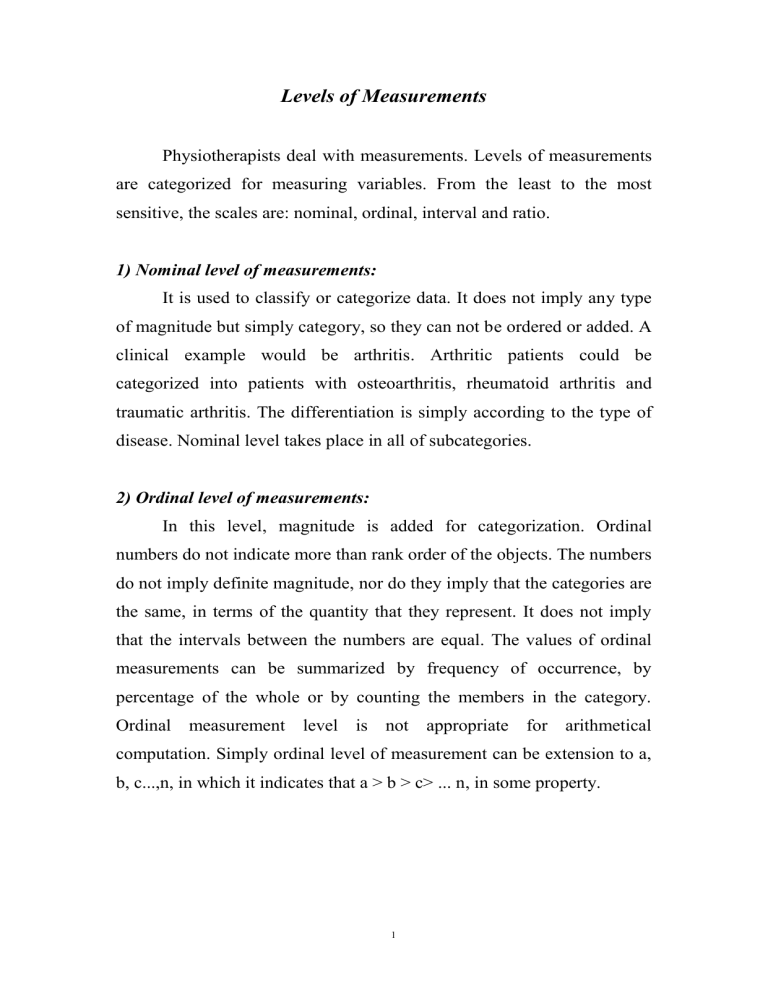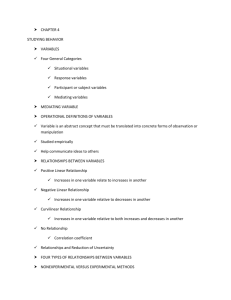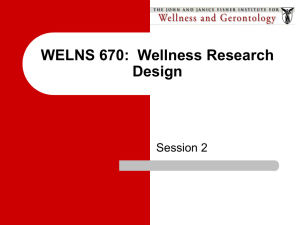LEVELS OF MEASUREMENTS

Levels of Measurements
Physiotherapists deal with measurements. Levels of measurements are categorized for measuring variables. From the least to the most sensitive, the scales are: nominal, ordinal, interval and ratio.
1) Nominal level of measurements:
It is used to classify or categorize data. It does not imply any type of magnitude but simply category, so they can not be ordered or added. A clinical example would be arthritis. Arthritic patients could be categorized into patients with osteoarthritis, rheumatoid arthritis and traumatic arthritis. The differentiation is simply according to the type of disease. Nominal level takes place in all of subcategories.
2) Ordinal level of measurements:
In this level, magnitude is added for categorization. Ordinal numbers do not indicate more than rank order of the objects. The numbers do not imply definite magnitude, nor do they imply that the categories are the same, in terms of the quantity that they represent. It does not imply that the intervals between the numbers are equal. The values of ordinal measurements can be summarized by frequency of occurrence, by percentage of the whole or by counting the members in the category.
Ordinal measurement level is not appropriate for arithmetical computation. Simply ordinal level of measurement can be extension to a, b, c...,n, in which it indicates that a > b > c> ... n, in some property.
1
3) Interval level measurement (scales):
This measurement includes all the qualities of the ordinal level measurements and also includes units that are equal in size. Also the distances between levels are equal. This permits the use of arithmetic operations and the zero point is arbitrary (e.g. centigrade temperature measurement, where zero does not indicate the absence of heat but rather is an arbitrary point).
4) Ratio level of measurements:
Ratio level of measurements includes all the qualities of the interval level of measurement. This level has the highest level of validity and also includes a zero point that is absolute (e.g.: Kelvin scale of temperature, where zero-degree Kelvin is absolute zero, indicating the absence of heat). In the ratio level of measurements, arithmetic operations are possible. Numbers on the scale indicate the actual quantitative data of the measured property.
2
Reliability, Objectivity and Validity
Measurements must be reliable and objective and the results must be valid. Reliability is the repeatability and the extent to which comparable results are achieved every time a test is repeated. If a muscle test is repeated by one or more therapists who obtain the same grade every time; then the test is reliable. The key to reliability for manual muscle testing is to follow the standard procedures, performing the test in the same way each time and in the same way that other therapists perform it. Reliability is increased if the therapist gives clear instructions to the patient.
Evaluation procedures should exhibit inter-rater and intra-rater reliability:
* Inter-rater reliability means that another person who performs the test should arrive at the same results, to an acceptable extent.
* Intra-rater reliability means that one person should come out with the same results on every repetition of the test, within acceptable level.
There are three methods that estimate reliability of certain measurement tool; test-retest, parallel-forms and split-half methods. For example’ inter-rater reliability test was done to examine the effects of goniometer size on the reliability of passive shoulder joint measurements.
It is concluded that goniometric passive measurement of the range of the shoulder joint motion can be highly reliable when taken by a single therapist (intra-rater reliability), regardless of the size of the goniometer.
Objectivity means that the findings are reported without distortion by personal opinion or feelings. Therapists should not let the patient to influence the results of an evaluation procedure. In manual muscle testing, the most difficult area to be objective is deciding whether the resistance the patient can tolerate is minimal, moderate or maximal.
3
If the patient's weakness is unilateral, the therapist should test the opposite side and use the result as the baseline for normal. If the patient has bilateral involvement, the therapist must relay on experience in testing other patients and normal subjects to know what is normal for a particular muscle in a person of a given age, sex, size and occupation.
Validity means that a test actually measures what it is supposed to measure. In muscle testing, therapists are testing the strength of a specific muscle. For a muscle test to be valid, the therapist must know the location and function of the muscle being tested and the location and function of surrounding muscles. Validity of assessment means that the therapists evaluate exactly what they are going to do and that the results are correct.
Types of validity:
1. Face validity:
Many of the measurements used in physical therapy clinical practice appear to be based on the assumption of face validity i.e. they are assumed valid as a result of inference. Face validity for a measurement is a lot-like the shine on a new car. It is a nice thing to have but you can not get very far more than nice. Face validity is the appearance of a justifiable use for a measurement but does not mean there have any data or theory to support its use.
2. Construct validity:
Construct validity of a measurement is made through the logic; used existing knowledge. It is a theoretical form of validity, which supports the use of a measurement for a specific inference. There is no absolute way of knowing when measurement has construct validity. The manual muscle test was developed with a clear construct in mind. When poliomyelitis was widespread, manual muscle test was developed to characterize weakness caused by the virus effect on anterior horn cells.
4
The construct was simple: fully innervated muscles can generate more tension than partially innervated muscles; while totally denervated muscles can generate no tension.
3. Content validity:
Content validity deals with how measurement schemes relate to their constructs, i.e. relating a measuring tool to a general theoretical framework in order to determine whether this tool tied to the theoretical assumption. The classic test of content validity is to ask whether we have chosen an adequate constellation of items to measure from the universe of items, defined by our construct.
4. Criterion-related validity:
Construct validity deals with the theoretical basis for a measurement. Content validity deals with implementation of theory. Both construct and content validity are based on theory and can never be directly tested. This is in contrast to criterion-related validity. Criterionrelated validity represents the ultimate test of validity. To demonstrate criterion-related validity, a measurement is compared to a criterion to determine whether or not the inference was appropriate. The measurement is tested by comparing it to something else, the criterion.
5








